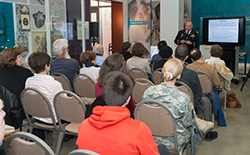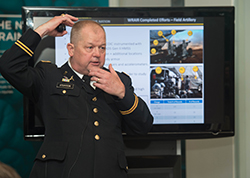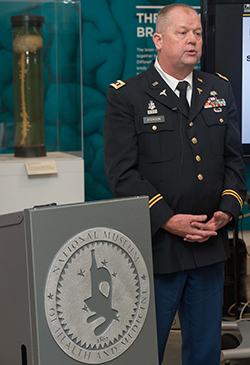Innovative sensor technology helps military fight brain injuries
By Paul Bello, National Museum of Health and Medicine
SILVER SPRING, Md. - Sensor technology developed by the U.S. Army is proving to have enormous benefits in determining how to better protect military soldiers in combat. The topic was featured during the March 2015 edition of the Medical Museum Science Café, a science forum presented by the National Museum of Health and Medicine (NMHM).
The discussion, entitled "Protecting the Brain in Combat," was led by Lt. Col. Chessley R. Atchison, program manager, Science & Technology Objective for the U.S. Army Medical Research and Materiel Command (USAMRMC). Atchison's work primarily focuses on transitioning basic research onward to advanced development in the assessment and treatment of traumatic brain injury (TBI). In addition, he also performs research efforts on the effects of post-traumatic stress disorder (PTSD).
"The military refers to the transitioning from basic research to advanced development as the ‘acquisition valley of death,'" Atchison said at the outset of his presentation. "It comes down to how you will deliver something to the war fighter. This is of utmost importance to the Army, so a lot of research and time has gone into this project."
Atchison, a veterinarian with 26 years of active-duty service, never hesitated when leadership asked him to spearhead this scientific endeavor. While serving as commander of the U.S. Army Center for Health Promotion and Preventive Medicine at Fort Meade, Md., a female colleague suffered a TBI and later had severe bouts of PTSD. She would later commit suicide. After the death of his friend, Atchison says it became a personal goal of his to help as many service members who are suffering from the same symptoms.
As such, Atchison's research team is currently involved in evaluating environmental sensors for the detection of possible concussive events in the military training environment. Previous research has shown that more than 85 percent of TBI cases are diagnosed at the garrison level, while only 20 percent take place in combat situations. According to Atchison, the vast majority happen in regular duty stations. In addition, he says, motor vehicle accidents have also been another problem over the years.
"It is the signature injury over the last 15 years. It's my job to determine where these injuries are occurring," Atchison said. "Fort Bragg is home to the 82nd Airborne. One of their skillsets is to capture airfields. We thought it would be prudent to conduct an experiment with Airborne soldiers and follow combatives to determine the amount of blows to the head."
Atchison says a proper parachute landing fall for such a soldier has five total points of body contact. Due to varying wind conditions, however, soldiers don't always land on their feet and can often suffer head injuries on the tarmac due to the parachute causing their helmets to slap against the tarmac itself. It was determined that placing sensors inside those helmets might help measure the effects of head acceleration when receiving such a blow.
Atchison noted that some of the aforementioned deployed sensors currently being used in the combat theater are glued inside the crown of the helmet. Similar practices using different technology are now being introduced by the National Football League (NFL) and National Collegiate Athletic Association (NCAA). Additionally, there are more and more sensors available on the commercial market.
This kind of testing, Atchison said, will lead to what he calls a "concussion algorithm," which is a measurement of an environmental occurrence that can predict the probability of an injury that is, in turn, based on energy exposure. This development, however, wasn't without its flaws early in the process.
"One problem that was discovered in research was that the blast pressure would go over the helmet, so the sensors inside the helmet would never see the pressure wave," Atchison said. "Helmet sensors did measure acceleration, but the scientific problem was that it was measuring the helmet's acceleration and not the head. The transitional force between the head and helmet was lost."
Exactly how and where to place these sensors became crucial to his group in determining a proper reading, according to Atchison. Today, as a result of the group's research and various exercises, he hopes that medical policy can better help how a soldier is identified for treatment.
"We have developed two devices that have been cleared by the Food and Drug Administration (FDA) that should enhance the safety of our soldiers. A third is applying for FDA clearance later this spring," Atchison said. "The ingenuity of the American soldier is the greatest thing there is. It's been a team effort. These devices are the first to be cleared with a science and technology objective. I'm very proud of that."
NMHM's Medical Museum Science Cafés are a regular series of informal talks that connect the mission of the Department of Defense museum with the public. NMHM was founded as the Army Medical Museum in 1862 and moved to its new location in Silver Spring, Maryland in 2012. For more information on the program, call 301-319-3300 or visit www.medicalmuseum.mil.

|
Caption:
Lt. Col. Chessley Atchison, program manager, Technology Enabled Capabilities Demonstration, U.S. Army Medical Research and Materiel Command, welcomes guests to the monthly Medical Museum Science Café hosted by the National Museum of Health and Medicine in Silver Spring, Md. March 24. (Disclosure: This image has been cropped to emphasize the subject.) (National Museum of Health and Medicine photo by Matthew Breitbart / Released) |

|
Caption:
Lt. Col. Chessley Atchison, program manager, Technology Enabled Capabilities Demonstration, U.S. Army Medical Research and Materiel Command, discusses the importance of protecting the brain in combat during the monthly Medical Museum Science Café hosted by the National Museum of Health and Medicine in Silver Spring, Md. March 24. (Disclosure: This image has been cropped to emphasize the subject.) (National Museum of Health and Medicine photo by Matthew Breitbart / Released) |

|
Caption:
Lt. Col. Chessley Atchison, program manager, Technology Enabled Capabilities Demonstration, U.S. Army Medical Research and Materiel Command, discusses the importance of protecting the brain in combat during the monthly Medical Museum Science Café hosted by the National Museum of Health and Medicine in Silver Spring, Md. March 24. (Disclosure: This image has been cropped to emphasize the subject.) (National Museum of Health and Medicine photo by Matthew Breitbart / Released) |



